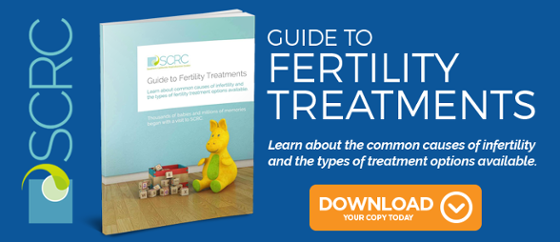
Recurrent or repeated implantation failure (RIF) can be devastating. Some patients undergo three or more rounds of IVF and everything seems to go well: a good number of eggs at retrieval, a good fertilization rate, the embryos appear to be healthy and high quality, the uterine lining looks good, the transfer goes smoothly, but the pregnancy never “sticks.”
It can also be a tricky and frustrating situation for fertility experts trying to track down a cause. Patients need answers, and doctors want to help. Happily, new tests and technology are constantly under development to help reproductive experts provide some of these answers and help patients find the right path to pregnancy. The ERA test is one of these new developments, which is offering new information and new hope to patients coping with implantation failure.
Here’s what you need to know.
What causes implantation failure?
There are several possible factors which can cause implantation to fail. Most fall under two categories.
- Genetic abnormalities: Most commonly, the issue is a genetic or chromosomal problem with the embryo, particularly with older women using their own eggs. Aging eggs have a much higher rate of chromosomal abnormality. This explains why implantation rates go down as the patient age goes up: in patients under 35 using their own eggs, the average implantation rate is about 50%. By the time women are 41-42 years old, that rate drops to around 12%. Very rarely, there can also be a genetic problem with the sperm. If a patient is struggling with RIF, genetic testing such as Pre-Implantation Genetic Screening (PGS) is usually a first-line recommendation. The embryologists can check the embryos for any chromosomal issues before they are implanted, which can significantly improve the implantation rate. Another highly effective option in this type of situation is to use donor eggs.
- Uterine receptivity problems: If there does not appear to be a genetic reason for implantation failure, testing will usually move on to receptivity issues with the uterus. These can be caused by many things: anatomical problems with the shape and/or positioning of the uterus, disorders or imbalances of the hormones, thyroid, or autoimmune functions, or problems with the endometrial lining itself. There are many different tests which can help doctors narrow down the issue. The ERA test is one of the latest.
What is the ERA test?
ERA stands for Endometrial Receptivity Analysis (or Array). It is a genetic test which uses a small sample of a woman’s endometrial tissue to evaluate whether or not the endometrial lining is prepared to accept an implanting embryo.
Each woman has an “implantation window” in her cycle which is a few days long, generally occurring from the 19-23 days of the menstrual cycle. During this time, the luteal or secretory phase, the ovaries are producing progesterone. The progesterone causes many subtle but important changes to the uterine lining in order to create a perfect state for implantation. Proteins are created which make the lining thicker and more receptive. In about 84% of women this small window occurs at the expected time. However, researches at Igenomix labs in Spain discovered that about 16% of women have a unique window which can be earlier or later than expected. For IVF cycles, this could mean that the embryo transfer is happening on the wrong day, when the window hasn’t opened yet or has already closed, thereby causing implantation failure.
How does the ERA test work?
When the endometrial lining is receptive, the genetic material of the endometrial cells have a unique “expression,” which means that they may be making more or less of certain types of RNA. The researchers analyzes the expression of 236 genes per sample and built up a database of more than 12,000 samples of endometrial tissue to see the levels of RNA produced at different times of the cycle. They then used advanced computer algorithms to look for patterns until they could reliably classify a sample as "Receptive” or "Non-Receptive” according to its specific expression profiles. This test is highly reproducible, which means that when samples are tested at the same time of the cycle but months apart, the results remain the same. Using ERA, doctors can identify whether a woman’s “implantation window” is happening when expected or whether they need to move the transfer date to ensure the best “sync” between the embryo and the uterine lining.
How is the ERA test performed?
Endometrial Receptivity Analysis requires a sample of the uterine lining obtained at a very specific time in the cycle.
It is also possible to use fertility medications to prepare the uterine lining, using supplemental estrogen and progesterone. The day the progesterone is started is Day Zero, and the test is done five days after that.
The tissue sample is taken in a procedure known as endometrial biopsy. A thin catheter is inserted through the cervix into the uterine cavity, and a plunger in the catheter is used to create suction and draw a tiny sample of the endometrial lining into the catheter. Many women find this part of the process quite uncomfortable, but it is a very quick procedure. The sample is then sent to the lab for analysis using Next Generation Sequencing technology. Results are available in around three weeks. If the results come back that the tissue was “Non-Receptive” then the test should be repeated earlier or later, until the optimal time is identified.
Once the patient’s receptive window has been identified, personalized embryo transfer (pET) timing can be used.
After so much emotional, physical, and financial investment, the disappointment and distress caused by repeated implantation failure is often severe. If you or someone you care about has struggled with failed IVF cycles which are unexplained, consider asking your fertility expert about ERA. It offers you a new data point, and information is power. Sometimes a shift of one day is all it takes to see success after repeated implantation failure.
Share this on social media:





